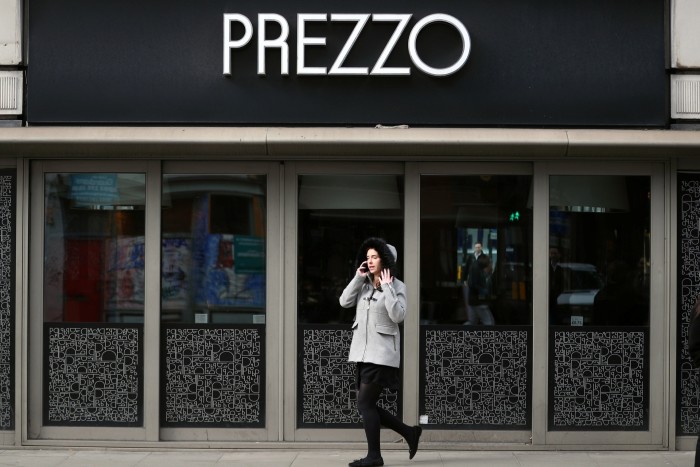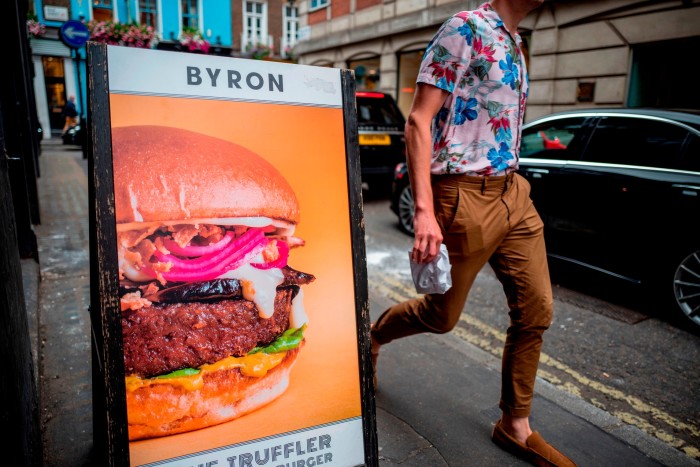The troubles of the UK casual-dining sector are writ small in the English market town of Maidstone. Just a few streets apart, an outlet of Italian-American themed diner Frankie & Benny’s and a branch of Italian restaurant Prezzo have shut in the past six months alone.
As consumers cut spending in response to the cost of living crisis and high input costs erode businesses’ margins, mid-market restaurant chains — which have in recent years rapidly expanded beyond city centres into towns across middle England — are struggling to recover from the lows of the pandemic.
In the 12 months to March this year, the number of casual-dining outlets across the UK fell 4.2 per cent to 5,160 nationwide, declining at nearly double the rate of the pub sector, according to data from CGA by NielsenIQ and AlixPartners.
Within the hospitality industry “the squeezed middle is suffering the most”, said Milly Camley, chief executive of the Institute for Turnaround, the trade body for advisers helping distressed businesses avoid bankruptcy. “Either people are forking out on expensive treats or trading down, so anything in the middle is finding it really difficult.”
The shakeout is proving brutal: Frankie & Benny’s owner The Restaurant Group, Prezzo, Richard Caring-owned chain Bill’s and burger joint Byron have announced more than 100 closures between them this year.
Wagamama owner The Restaurant Group, the only listed casual-dining group, is wrestling with a group of activist funds, which own up to a fifth of the stock collectively, and are pushing for a strategic shake-up because of the poorly performing share price.

Prezzo last month cut a third of its estate, or 46 sites, putting 810 jobs at risk, as its chief executive Dean Challenger lamented “the hardest times” he had “ever seen for the high street”.
Entrepreneurs Luke Johnson and Hugh Osmond have done more than most to push casual dining into the mainstream. After buying PizzaExpress for just £13mn in 1992, and taking it public a year later, they grew its estate fivefold to 200 sites within five years. But now they are far less bullish about the sector.
Johnson told the Financial Times he thought casual dining had “peaked for this economic cycle at least” as “a hangover of debt and a lack of investment” resulting from the pandemic, when multiple operators entered into administration, meant some chains would never fully recover. The number of casual-dining sites was down 16.2 per cent in the three years to April 2023, according to the Local Data Company.
Osmond was even more pessimistic. “The casual-dining chains, as was, are largely dead,” he said. “That doesn’t mean if you fast forward five years someone won’t have reinvented it . . . but what you won’t see is just the re-emergence of that broad-menu, middle-market, nothing remarkable type of casual dining.”
The problems for the sector predate the pandemic. Private equity takeovers had led to a pressure to expand beyond marquee locations in city centres — often into smaller towns with lower footfall — and made it difficult for businesses taking on a lot of debt.

CGA data suggests that the sector was already in decline from 2018 onwards because of cost rises and the growth of takeaway food options, but then the pandemic further exposed these weaknesses, according to Peter Martin, an industry analyst.
Celebrity chef Jamie Oliver’s restaurant chain Jamie’s Italian was one of the highest profile casualties of the sector’s decline, falling into administration a year before the pandemic, resulting in the loss of about 1,000 jobs.
Oliver is relaunching in London later this year but notably with a more premium offering to rival Caring’s Ivy restaurant chain. People familiar with the launch plans said the reason for not returning to the UK mid-market dining scene was because the sector is “increasingly crowded and uneconomic”.
High input cost inflation affecting everything from labour to food and drink to energy in the past year is now leading to another round of closures.
In the year to April, food and drink inflation stood at 19.1 per cent, well ahead of the headline inflation rate of 8.7 per cent according to the Office for National Statistics.
Overall, like-for-like sales at British restaurants were up 2.5 per cent in March, compared with the year before, according to CGA — but Martin said this headline figure masked how “mainstream, family-driven” chains were taking “a more severe hit” as consumer confidence wanes.
The upshot is that for a single restaurant site with a full service menu to break even nowadays, it needs to be making upwards of £30,000 a week, estimated Osmond — which he argued was “basically unviable” for those outside of marquee locations. Other options are for chains to pivot away from table service to save on labour costs, as chicken chain Nando’s has done, or slim the menu down to focus on one food item, but “something has to give”, he added.
Mark Selby, chief executive of Mexican restaurant chain Wahaca, which has 13 sites nationwide, predicted that cost pressures would lead “some fat to be trimmed away” in the casual dining sector.
“If the quality starts falling away because you are cutting costs, which some businesses have been forced to do to avoid bankruptcy, then that becomes dangerous,” said Selby. “Mediocre always falls away, but if you can keep it innovative and original then you will be OK.”
In what Johnson describes as “a bullish sign” for the sector, Japanese food conglomerate Toridoll is finalising a deal to buy Fulham Shore, which owns pizza chain Franco Manca and The Real Greek restaurants, for £93.4mn, with plans to expand in the UK and internationally. “The weak are disappearing but the strong are getting stronger,” added Johnson.





